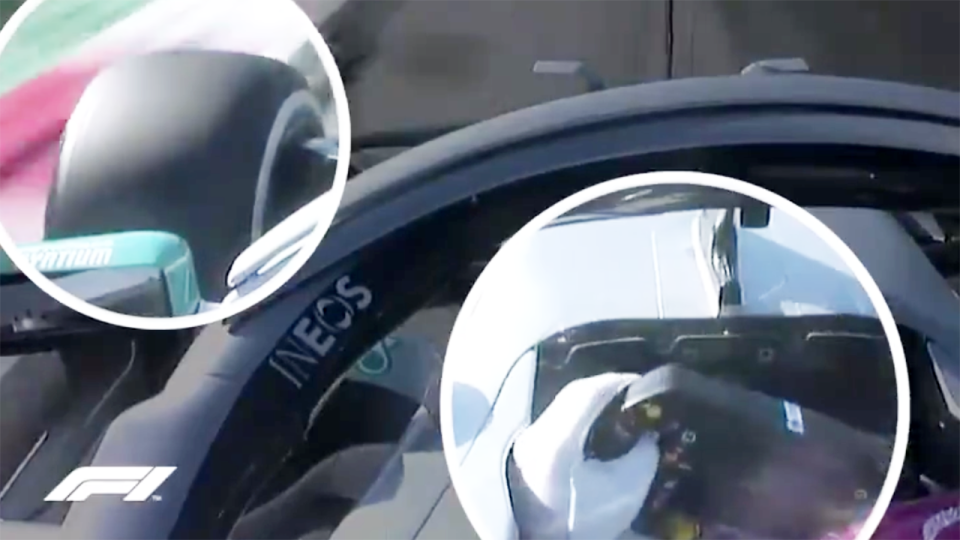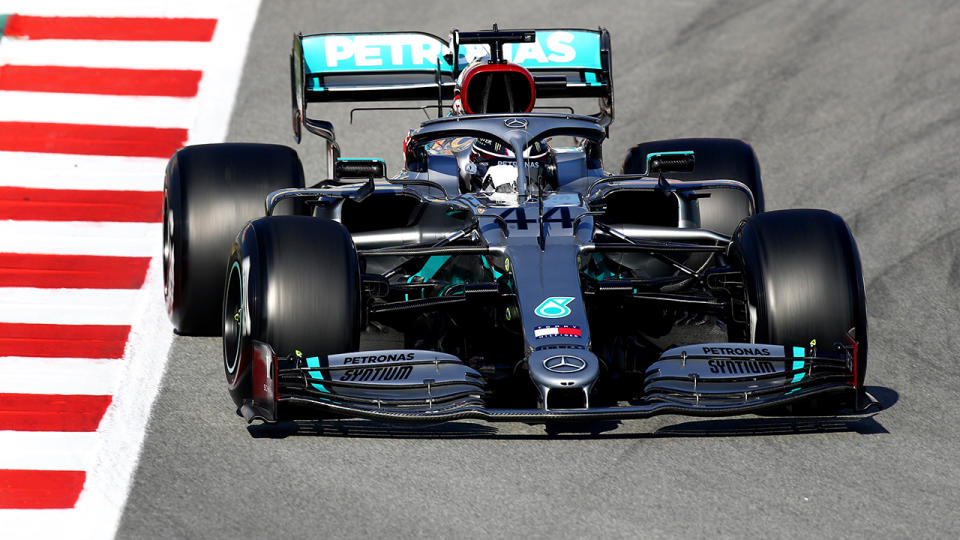'How is that legal': Mercedes' 'game-changing' device rocks Formula One
Mercedes have introduced an “extra dimension” to the steering of their car for the new Formula One season, insisting it is within the rules.
World champion Lewis Hamilton was seen on an on-board camera using the so-called Dual Axle Steering (DAS) on the second day of pre-season testing in Barcelona on Thursday.
‘KB24’: Beautiful message in Daniel Ricciardo's new helmet design
Hamilton could draw the steering wheel towards him on the straight and then release it before a turn, causing the wheels to turn slightly inwards.
It is thought the system will help better regulate tyre temperature.
Mercedes engineer James Allison was quoted on the F1 website as saying: "I probably won't shed a great deal more light than what you saw on the TV but, yeah, we have a system in the car, it's a novel idea.
"We've got a name for it, it's called DAS, if you're interested, and it just introduces an extra dimension for the steering, for the driver, which we hope will be useful during the year.
"But precisely how we use it and why we use it, that's something we will keep to ourselves."
Mercedes believe the system is perfectly within rules
"The rules are pretty clear about what's permitted on steering systems and we're pretty confident that it matches those requirements," Allison said.
We call it DAS - Dual Axis Steering! 🛠 James has an update on today's hot topic of #F1Testing... 👇 pic.twitter.com/kKDHJqzutK
— Mercedes-AMG F1 (@MercedesAMGF1) February 20, 2020
Hamilton said he was still trying to get used to the system, but praised the team for coming up with the innovation.
“I've only had one morning on (it, so) I don't really have a lot to talk about with it. We're trying to get on top of it, understand it, but safety-wise no problem today and the FIA are OK with the project.
“For me it’s really encouraging to see that my team is continuing to innovate and stay ahead of the game, and I think that’s down to the great minds in the team and so hopefully that’ll work to our benefit.”

F1 pundit Mark Hughes described the new device as a ‘game-changer’, outlining how it will put Mercedes even further in front of their rivals.
“Typically an F1 car will be set up so that its front wheels are aligned with ‘toe-out’, which simply means that they splay out at the bottom away from the centre of the car, with the top pointing inwards,” he wrote on Thursday.
“However, this means that on the straight the inner edge of the tyre’s tread surface is being heated up more than is the remainder of its width.
“If the Mercedes mechanism works as assumed, the tyres will be heated more evenly across their width as they run fully upright, but the benefits of toe-out can still be deployed into the corner. It will be of particular benefit on circuits with long straights.”
This is utterly clever from Mercedes. Imagine you come back from the winterstop and the team tells you they’ve thought of a new thing and come up with this... makes you pumped up for the new season. pic.twitter.com/1jd0RIwqYz
— Giedo van der Garde (@GvanderGarde) February 20, 2020
Whoa.
Thread. Mercedes is changing toe (and what else?) on the fly in testing. Watch the wheels, and Lewis pulling the wheel. Clever.
Also: Maybe I'm an idiot, but can someone explain to me how this is legal? https://t.co/9YNPQXvB6x— Sam Smith (@ThatSamSmith) February 20, 2020
If Ferrari did this, there’d be a sea of cheating allegations. But because it’s Mercedes, it’s a cool innovation 🙄💁🏼♂️ https://t.co/jgq3S0QJ50
— Nick Bennetts (@NickBennetts12) February 20, 2020
Hamilton slows down on Thursday
Hamilton led the time charts on Wednesday but was only ninth-fastest on Thursday.
The 40-year-old Kimi Raikkonen, who has a chance this season to break the record for most race starts in F1, was fastest with a time of 1 minute, 17.091 seconds in his Alfa Romea.
He was 0.2 seconds quicker than Sergio Pérez with Racing Point. Daniel Ricciardo of Renault was third.
Raikkonen caused a red flag near the end of the afternoon session when his car stopped on the track with an apparent mechanical issue.
The Finnish driver had spun earlier in the session, as did Valtteri Bottas of Mercedes, Romain Grosjean of Haas and Pierre Gasly of Alpha Tauri, formerly known as Toro Rosso.

Grosjean had the most laps among the 13 drivers who went to the track on Thursday, with 158.
Bottas was the slowest driver of the day, while Sebastian Vettel was sixth-fastest with Ferrari.
Pérez had set the quickest time in the morning session. The Mexican driver had been third fastest on Wednesday, behind Hamilton and Bottas.
Drivers will be back on the track on Friday to close out the first week of testing. Teams will have another three days to test next week.
Preseason testing has been reduced from eight to six days to help compensate for the record 22 races on the calendar, including a new Vietnam Grand Prix and the return of the Dutch GP. Midseason testing also has been eliminated.
The season opens on March 15 at the Australian GP.
with agencies

